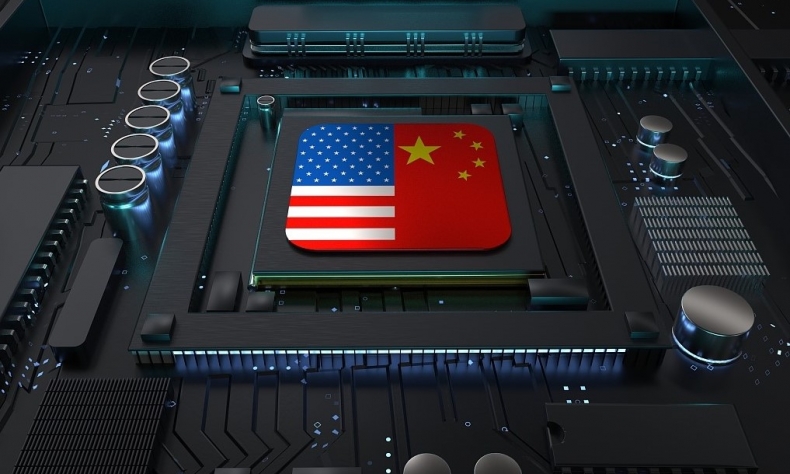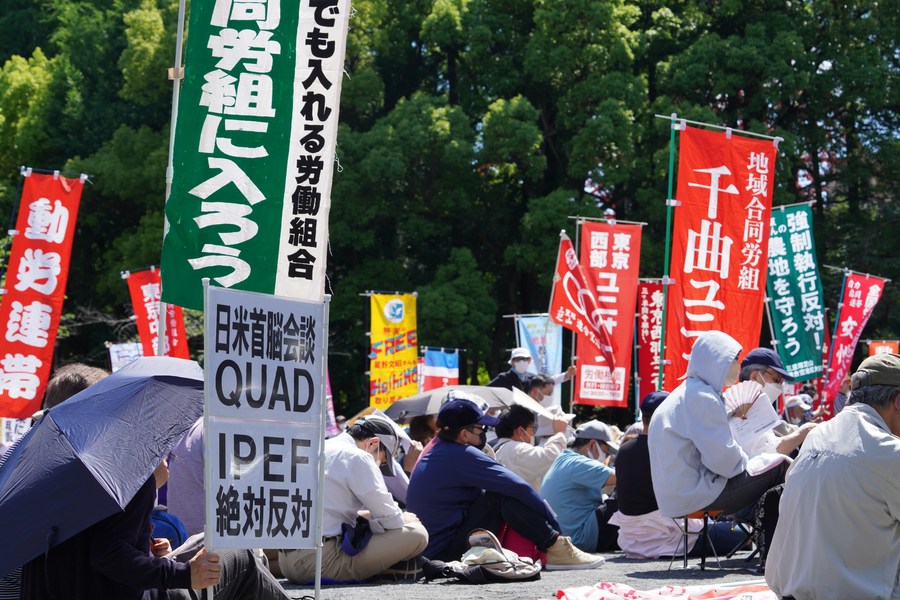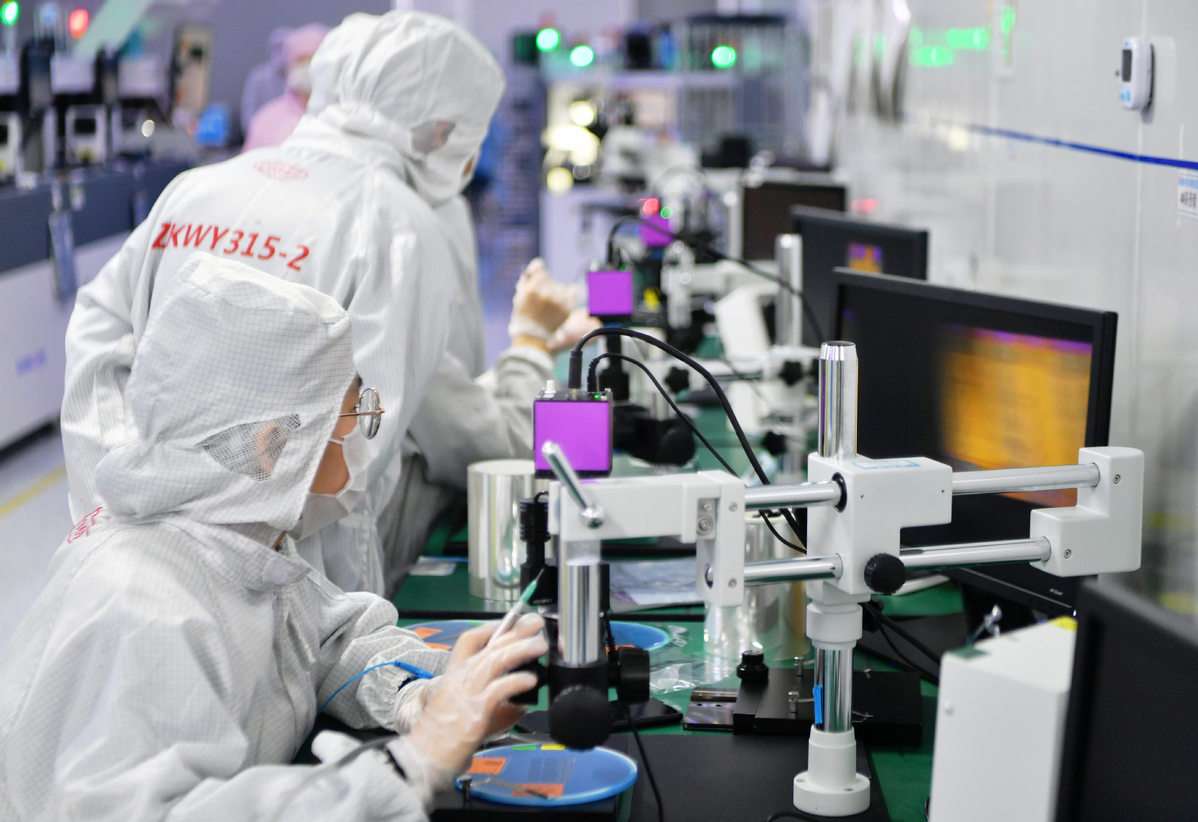American Security Excuses

The U.S. exaggerates the so-called ‘security threats’ posed by China’s development to cover up its true intention of suppressing China’s economic growth and sustaining its own hegemony.
In recent years, the United States has disregarded internationally recognized trade rules and arbitrarily used its hegemony to stifle China’s hi-tech industrial development under the pretext of security.
In the hi-tech sector, it not only imposes restrictions on American companies exporting to China, but also uses long-arm jurisdiction to prevent other countries from cooperating with China.
From August 1, 2018 to June 14 this year, the U.S. departments of treasury, commerce and defense imposed sanctions on no fewer than 1,141 Chinese companies. In addition, the U.S. is imposing unreasonable requirements that exports of products containing more than 25 percent American technology, or products that do not contain restricted American technology but are deemed to be designed or manufactured using U.S. technology, must receive special government approval before being sold to China.
Beginning in 2022, the U.S. reached agreements with the Netherlands and Japan to tighten controls on the export of semiconductor equipment, such as lithography machines, to China.
In addition, the U.S. has expanded its restrictions on investment in China’s hi-tech sector, not only targeting its own companies but also preventing other countries from making normal investments in China. The U.S. has formed the so-called “Chip 4 Alliance” with Japan, the Republic of Korea (ROK) and China’s Taiwan Province. It also offers substantial subsidies to foreign companies investing in the U.S., while requiring the recipient semiconductor companies (including non-U.S. companies) not to invest in China for the next decade.
The U.S. is rallying other nations to create “clubs” to exclude China. In recent years, the U.S. has established the EU-U.S. Trade and Technology Council with the European Union and proposed the Indo-Pacific Economic Framework in the Asia-Pacific region, both designed to exclude China. Meanwhile, it is steadily promoting the Quad (U.S., Japan, India and Australia) strategic security dialogue and expanding the U.S.-Japan-ROK alliance to contain China’s peaceful rise.

True lies
The U.S. exaggerates the so-called “security threats” posed by China’s development to cover up its true intention of suppressing China’s economic growth and sustaining its own hegemony.
First, it attributes normal cyclical changes in industrial development to being squeezed by China’s growth. It is natural for many industries to prosper and decline due to scientific and technological development. Yet some American politicians disingenuously blame it on China’s industrial development.
For instance, it is common for heavy industries like the steel industry to contract after industrialization reaches maturity. Yet U.S. Secretary of State Antony Blinken and Trade Representative Katherine Tai have attributed the decline in U.S. steel production to China’s steel sector growth. In reality, although China’s steel output did increase from 130 million tons in 2000 to 1.01 billion tons in 2022, the vast majority was for domestic use. In 2022, China’s net steel exports amounted to just 57 million tons, making up 5.6 percent of total production, largely bound for steel-deficient countries like the ROK and Viet Nam. Exports to the U.S. were a mere 989,000 tons, just 1.2 percent of U.S. production of 80.715 million tons that year. Even in 2014, when China’s steel exports to the U.S. peaked, they were 3.4 million tons, just 3.9 percent of American steel output at the time.
Second, under the pretext of “national security,” the U.S. restricts hi-tech product exports to China with the actual intent of constraining the latter’s industrial development.
The U.S. justifies controlling hi-tech exports to China in the name of preventing their use in military and defense applications. On April 20, U.S. Treasury Secretary Janet Yellen asserted that safeguarding certain technologies from China’s military and security apparatuses is of “vital national interest” to the U.S.-China economic relationship during a speech at the Johns Hopkins School of Advanced International Studies. She further stated, “These national security actions are not designed for us to gain a competitive economic advantage, or stifle China’s economic and technological modernization.” However, in reality, the true objective of export controls is to undermine China’s hi-tech industrial development and maintain U.S. technological and economic dominance.
For example, on August 31, 2022, the American Government began restricting chip makers Nvidia and AMD from exporting their latest flagship A100, H100 and MI250 AI GPU chips to China, despite the primary application of these targeted products being in artificial intelligence.

Third, the U.S. is distorting the facts by exaggerating China’s control over minor links in the supply chain and falsely portraying “insecurity.” On April 27, at the Brookings Institution think tank, U.S. National Security Advisor Jake Sullivan stated, “Today, the United States produces only 4 percent of the lithium, 13 percent of the cobalt, 0 percent of the nickel and 0 percent of the graphite needed to meet the demand for electric vehicles. Meanwhile, over 80 percent of critical minerals are processed in one country—China.” What Sullivan omitted is that while the U.S. produces little of these critical minerals domestically, it controls significant global mineral resources. In addition, the U.S. repeatedly emphasizes its inadequate control over the field of semiconductors. Also at Brookings, Sullivan stated, “America now produces only about 10 percent of the world’s semiconductors and production is geographically concentrated elsewhere.” But what he failed to mention here was that of the world’s top 15 semiconductor companies, eight are American, accounting for 48 percent of global sales in 2020—well ahead of other nations. It is countries like China that should feel insecure.
Fourth, the U.S. disregards China’s tremendous progress in intellectual property rights protection and market opening, while constantly assailing China’s market landscape. In her April 20 speech, Yellen asserted, “China also imposes numerous barriers to market access for American firms that do not exist for Chinese businesses in the United States.”
In reality, however, China has placed great importance on safeguarding the intellectual property rights of domestic and foreign enterprises alike in recent years. According to the World Intellectual Property Organization’s 2021 Global Innovation Index, China ranked 12th, climbing two spots from 2020 and sustaining an innovation-leading momentum for nine straight years. The European Union Chamber of Commerce in China’s Business Confidence Survey 2021 showed 50 percent of surveyed EU firms believe China’s IP enforcement efforts are adequate or very good.
Fifth, disregarding economic common sense, the U.S. maligns China’s economic growth for purportedly impacting U.S. industry and advancement.
However, after China entered the World Trade Organization in 2001, the U.S. economy made tremendous strides. From 2000 until the 2008 global financial crisis, U.S. per-capita GDP expanded from $36,000 to $49,000. The average unemployment rate was only 5.05 percent and steadily declining, hitting a historic low of 3.6 percent in 2019.

Even Yellen acknowledged at Johns Hopkins that “since the end of the Cold War, the American economy has grown faster than most other advanced economies. And over the past two years, we have mounted the strongest post-pandemic recovery among major advanced economies. Our unemployment rate is near historic lows. Real GDP per capita has reached an all-time high.” She added, “America is the largest economy in the world, but it also remains an unparalleled leader on a broad set of economic metrics—from wealth to technological innovation.” With the U.S. economy developing so robustly, how could China’s growth have negatively impacted it?
China’s response
The U.S. has a track record of suppressing the technology of other countries to maintain its own hegemony. To hinder Japan’s economic ascent, it compelled the appreciation of the yen and constrained Japanese exports. Now, the U.S. is obstructing and suppressing China’s hi-tech industries, continuing its longstanding practices.
In spite of the U.S. hegemonic moves, China will always prioritize its development based on its own strengths. By continuously strengthening intellectual property protections, deepening science and technology system reforms, China will overcome U.S. hi-tech containment through its own efforts and persist in protecting its industrial and economic security.
As a responsible major country, China will steadfastly pursue high-level opening up, promote building a community with a shared future for humanity and follow the path of mutual benefit and win-win cooperation. The fruits of China’s development will benefit not just China’s 1.4 billion people, but furnish more development opportunities worldwide and become an important driving force for global development.
The author is deputy director of and a researcher with the Industrial Economics Research Department of the Development Research Center of the State Council.
 Facebook
Facebook
 Twitter
Twitter
 Linkedin
Linkedin
 Google +
Google +










